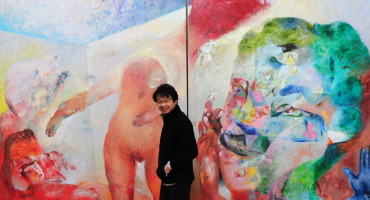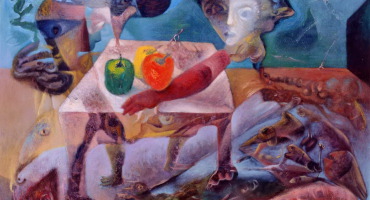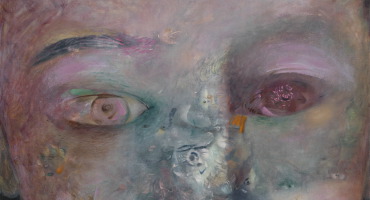“Myth is a form of expression which reveals a process of thought and feeling – man’s awareness of and response to the universe, his fellow men, and his separate being.” (The Cry for Myth) (1)
At noontime on September 20th, 2008, on the civic plaza in France’s VanGogh Park in the City of Auvers-sur-Oise, a few Taiwanese friends and I were witnessing the starting point of the art endeavor, “Sign Me”. It began with the mayor, Mr. Béquet, signing his name on the four-meter high sculpture, “Outstanding in the World”, and in the subsequent twenty minutes, the white body of the artwork was filled with people’s signatures. With each signature, a connection was made with Alixe Fu’s work. The mayor than led the big crowd of the city’s citizens and the continuously increasing visitors by walking through the well-planned City of Auvers-sur-Ois and visiting each historic site and VanGogh related locations along the voyage. Each site had a sculpture by Alixe Fu installed, and as the signing troupe began to expand, upon arriving at the final destination, Château d’Auvers, over two hundred and nearly three hundred people had gathered. Over hundreds of people congregated there to celebrate the communal memories they had just created for the city, and during the month-long exhibition, all the sculptures were filled with various signatures. In the end, the sculptures were transported back to Alixe Fu’s studio in France to be processed with the second production procedure, where paint would be coated on these sculptures covered with signatures. These names would conglomerate in the paints, and each sculpture would no longer be an individual character; they would become sculptures embedded with collective memory.
These meanings would be transmitted around the world through modern day technology, and this is where the action of the painted sculptures of “Sign Me” would begin. This endeavor would continue in Beijing in December and Taipei in March, 2009. This April on the plaza of the Museum of Contemporary Art Taipei, these sculptures would fill the space, and they will begin to collect the hundreds of Taiwanese people’s names.
The questions stirred are what are these sculptures, and how are they formed? What defines their joy, anger, sadness, and blissfulness? Are emotions and desires growing? What are the relationships with the physical body? To comprehend these questions, one must start with understanding Fu’s two-dimensional works. I’ve once written an analytical article about his paintings, and it stated that:
Alixe Fu’s paint strokes express the physical body, the desires, and the absurdities in life. What you would see is the key image deriving from the body, and some characters are men and other women, and some are androgynous. Some of them can be deciphered as a singular being, while others appear to be a singular person with two shadows, and others have multiple faces or sets of eyes that are embodied in one physical form. Other times, one solitary body would have multiple limps growing from of it, and other times, a foot would have excessive toes expanding out. Alixe Fu explains that these bodies are extremely acute due to the connections with desires. Desires also bring quandaries and concerns, and these feelings can also kindle the energy for action. He has endless stories to tell, and infinite faces to paint, and there are spirits that he continuously attempts to capture. This story-teller does not stay aloof or wields a mighty pen to pass judgment; on the contrary, his brush strokes are inconclusive and wavering without definitive lines or absolute colors. (2)
Alixe Fu’ sculptures are derived from his paintings, sketches, or ordinary people, and we can see that his deconstruction of the facial features and four limps, eyes, fingertips, backbones are all not by scale. Sometimes we could even see them being disorientated and severed from the body. To make a comparison of the final completed colored sculptures to his sketches is quite interesting, as it’s similar to computer animation that has become alive by evolving from two-dimensions. Alixe Fu transforms the originally flat allegories into solid sculptures; however, he is not able to use irresolute brush strokes to blur the boundaries, and is not able to use indecisive spaces to enhance the indistinguishable perspectives. These sculptures seem to be his way of deconstructing and reconstructing flat paintings. This cycle of deconstruction → reconstruction → deconstruction, is his structure for the ever-changing truth in life; therefore, when painting, his context continues to change, revolve and expand, and the image presents multiple focal points that make the observers feel a sense of déjà vu and also a feeling of being lost. However, when sculpting these characters, Alixe Fu is no longer smearing the focus, he uses three-dimensional sculptures to reconstruct and make definite the allegories implied. Imagination is transfixed on a single point, and the characters are than able to become ever more distinct.
In the “Sign Me” project, Alixe Fu has created seventeen different sculptures, and they are: “Angel”, “Ms. Butterfly”, “Ambassador”, “Bravery”, “A Cup of Wine”, “Administrator of the Temple”, “Actor”, “Fluffy Skirt”, “Great Mr. Mao”, “Trumpeter”, “Father and Son”, “Dragonfly”, “Fly”, “Woman Pouring Water”, “Running Woman”, “Brothers”, and “Outstanding in the World”.
When grouped together, the sculptures appear to be a magnificent human troupe. Prior to being painted with colors, the white sculptures were placed at different spots on the plaza, lobby, scenic site, lawn, shrubbery, and their pristine white figures seemed to have been dusted with a sacred glow, and sometimes appeared to be giving the specific site a blank space that is quite humanistic. The signing project in Auvers-sur-Oise had this kind of charm. The “Running Woman” was placed on the outdoor lawn of the renowned VanGogh Park, and it reminded one of the particular famous painting of the trembling church by VanGogh. The experience formed an adjacent and disoriented juxtaposition of art history and style.
As for these sculptures, what exactly are they? How have they been created? Are the purely originations from allegories, or have they derived from real people? There are so many questions, but I have no intent in becoming an obsolete or belligerent critic, nor do I wish to force hard and inappropriate analytical views or pour my personal contemplations onto the original objective of the artist, which seems to have an approach based on forms. Therefore, I do not wish to define each piece of work, and will not specifically label which cultural trend led to the completion of a particular piece; after all, Alixe Fu has wandered in between the cultural systems of the East and West for nearly a quarter of a century. To analyze which modernistic thought does he fall into, or which eastern tradition has nurtured him does not seem to be able to provide any guidance to the audience when standing in front of these sculptures. I once wrote an article that perhaps could be considered as a general help towards understanding these characters; in the article I stated that:
The narrative qualities in his paintings aren’t pronounced, nor do they rely on literary expression, but are more appropriately described as ideographs. Italian abstract painter Francisco Clemente once said that their painting process was like inventing ideograms. Chinese characters are ideograms that have evolved based on the six classifications of pictogram, ideogram, compound indicative, phono-semantic compound, borrowed character, and derived character. Alixe Fu has provided us with a good deal of paintings that are like ideograms. Although these images themselves don’t contain any indication of time, objects or disputes, when put together they can describe a vast world and countless feelings. Alixe Fu is a competent painter of these ideograms, and not at all worried about repenting or setting examples, nor is he seeking to easily crush humanity (hatred, resentment, heretical or wanton descriptions are rarely seen in his works). His work doesn’t take a stand against society or serve as a tool of dissension (there are few political, violent or sexual topics in his work). Alixe Fu is essentially promoting a group of his figurative paintings and adding more to an already dense forest of pictorial works. This kind of artwork and the historical repression of figure painting in China are related.
Alixe Fu’s paintings also provide a fresh point of view. All of his paintings are of figures, but ultimately his paintings are about vitality and spirits, and this is why he usually only emphasizes the eyes, hearts, feet and hands of his figures, and is also why he doesn’t depict their genitals. These spirits present us with a reality, which is just like the complex dialectical relationship between the real and the fabricated, and ignite people’s imagination and thoughts, but also make reality progressively more clear. After continually reading his work, the confusion in his paintings becomes increasingly clearer. This also perfectly echoes the time line of developments in Alixe Fu’s work; from the confusion in his early work to the relatively stable and integrated paintings of today. Throughout this course, the body is continually deconstructed and reconstructed, and lust is extinguished and rekindled. However, the reality of life is established on this framework of continual dialectic. (3)
Starting with the signing event on September of 2008, these seventeen sculptures of allegoric characters have become closer to the people, and have walked towards you and me by inviting us to sign on their pristine bodies. Alixe Fu hopes, when faced with these sculptures, the allegory that resides in each observer would be made complete. The allegory no longer just belongs to Alixe Fu; it is shared with everyone. The white bodies also leave a great space for imagination, and through these characters, Fu is able to embrace the world. In reality, the artist has experienced the pain of loneliness and marginalization in his life, and through art, he has found a sense of belonging. His paintings have long been recognized by the art world, and for such a young talent, he should be proud of his accomplishments; however, this art endeavor of “Sign Me” has surprised me even more. He is no longer just a Bohemian ballad murmuring drifter; on the contrary, he has positioned his self vagrancy as an advantage, and has utilized this explosively powerful team of ambassadors to form an entire concept that will link together France, Beijing, and Taipei. These conceptual beings are filled with imaginations and symbols granted by each signatory, and will be travelling the world in containers.
In Alixe Fu’s statement it mentioned that:
“One kind of rice feeds a hundred different people”.
Alixe Fu’s sculptures signed by different people emphasize that according to the concept of Reincarnation in Asian culture, a person owes her/his existence to all of those who preceded her/him in life. This is a world of participation and sharing, and this breaks the “myth” that artists are the creators. Instead, the world shapes everyone and everyone also shapes the world.
This narrative embodies a self-contemplation and salvation towards the concept that “art is personal expression”. Having resided in France for a prolonged period and also having been detached from the public, Fu’s passion and longing for the crowd have almost reached a religious state. He has transformed from a story-teller into a pastor that strictly follows by the teaching of “the author is dead”. However being a loyal follower, to sign on the work to me is just a gesture of recognition for the artwork, and it even allows the observer to experience the moment of thrill the artist feels when signing a piece of completed work; however, I must say that the powerful style that he has created is continuously narrowing my focus, and is allowing me to pay focus on these characters’ strengths and their self-determination. My participation or signing of my name does not interfere with my approval and respect for Fu’s story-telling ability and creative vitality.
1. Rolla May, A Cry for Myth; Souvenir Press Ltd, 1993
2. A Clear Path from the Mists, 2008 Impressions Art Gallery
3. A Clear Path from the Mists, 2008 Impressions Art Gallery



